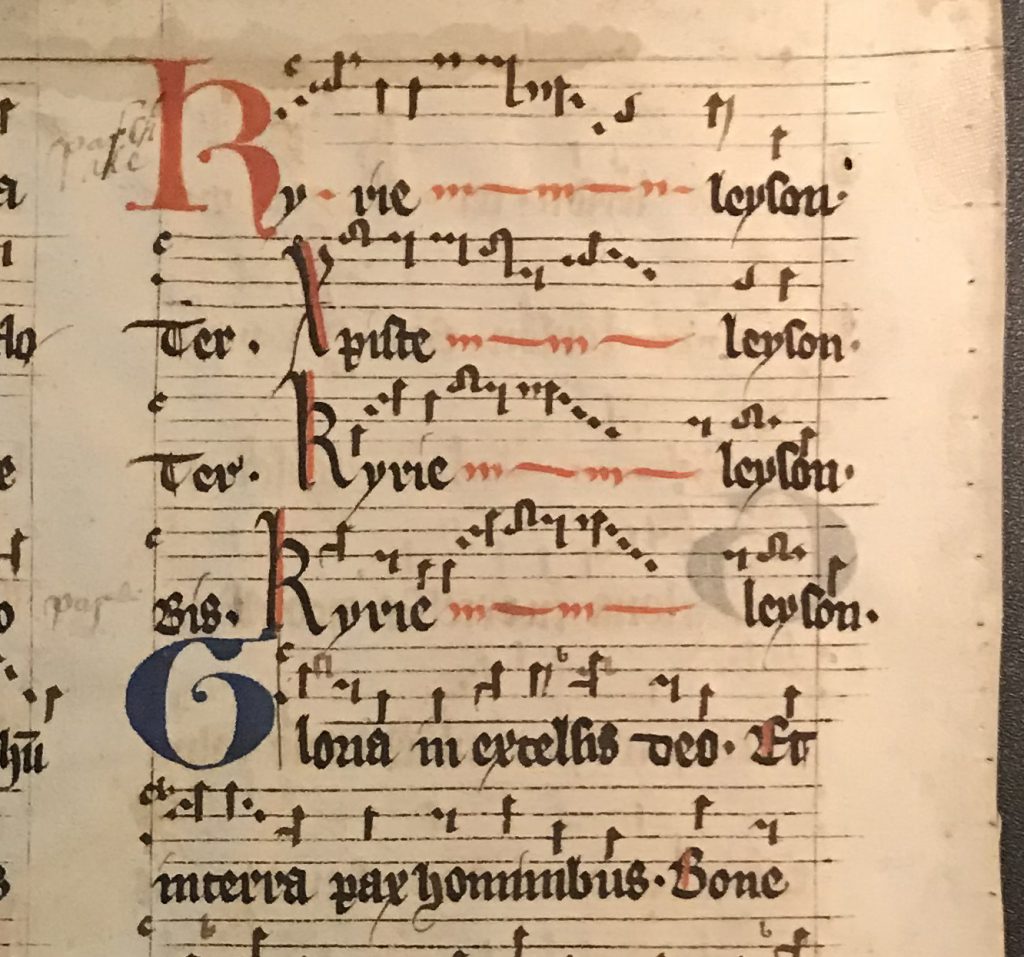The Weber Leaf from “The Warburg Missal” (Otto Ege Manuscript 22)
July 5, 2022 in Manuscript Studies
The Weber Leaf
from ‘Otto Ege Manuscript 22’
(The Warburg Missal)
Collection of Richard Weber
Latin Missal made in Germany circa 1325
Written in Gothic Script (Textualis)
Folio Number Absent
Double columns of 31 lines
Circa 360 × 257 mm < written area circa 289 × 190 mm >
with Rubrications,
Inset Initials in Red or Blue,
and Musical Notation in Hufnagelschrift (“Horseshoe-Nail Notes”)
on 4-Line Staves
[Posted on 5 July 2022]

Front Cover for Report by Leslie J. French for Wagner Leaf from Ege MS 22 (2021)
With thanks to the collector, Richard Weber, we examine a leaf from one of the manuscripts dispersed by Otto F. Ege (1888–1951). It comes from ‘Ege Manuscript 22’, a Latin Missal written in double columns of 30–32 lines in Gothic Script, with musical notation.
An earlier blogpost by Mildred Budny and the companion Report Booklet (2021) by Leslie J. French examine another Leaf from the same manuscript, set it in its former context, and re-assess the attribution of the book.
See:
- Another Leaf from the Warburg Missal in the Collection of J. S. Wagner.
- A Leaf from the Warburg Missal (“Ege MS 22”) containing part of The Mass for Corpus Christi and its Relation to Other Leaves.
Already, too, we have examined some other materials in the Collection of Richard Weber, with several blogposts — with more on the way.
- A Leaf from ‘Otto Ege Manuscript 214’ in the Collection of Richard Weber
- More Leaves from an Old Armenian Praxapostolos
- Portfolio 93 of Ege’s “Famous Books in Eight Centuries” in the Collection of Richard Weber.
Now we turn to a leaf from Otto Ege’s dispersals that stands outside a specific set of a Portfolio, but with its original Ege Label and mat. Normally, ‘Ege Manuscript 22’ would belong to the Portfolio of Fifty Original Leaves from from Medieval Manuscripts, as a specimen leaf in position Number 22 out of the 50. See, for example:
In this case, the Leaf must speak for itself.
Folio Number or Not
Note that the J. S. Wagner Leaf from the Wagner Missal, like various other leaves from the same manuscript, carries a medieval folio number in roman numerals at center top of the recto, close to the columns of text. As a reminder, we show that leaf.
Recto of the Wagner Leaf

J. S. Wagner Collection, Leaf from Ege Manuscript 22, recto. Reproduced by permission.
Verso

J. S. Wagner Collection, Leaf from Ege Manuscript 22, verso. Reproduced by permission.
The Ege Label for the Richard Weber Leaf
Note the pencil annotation at lower left, providing a revised number “#20” in a different sequence than the one established in the printed label: “22”. Rarely do Ege printed labels have revisions, but this one appears to belong to a different numbering system — that we have encountered before.

Collection of Richard Weber, Leaf from ‘The Warburg Missal’, Ege Label. Reproduced by Permission.
The added number, with its prefatory hash (#), closely resembles the number #13 added to the Ege label for a detached leaf from ‘Otto Ege Manuscript 19’ in the Collection of Stephen Wagner.

J. S. Wagner Collection. Otto Ege’s printed Label for his Specimens of Leaf 19 in the Portfolio of Fifty Original Leaves from Medieval Manuscripts. Western Europe, XII-XVI Century.

Wagner Collection, Leaf from Otto Ege Manuscript 19, verso.
That leaf is subject to one of our blogposts. See:
It appears that these two revised numbers belong to a single revised set.
They appear to be by the same hand, as part of a specific, shared, campaign of renumbering. Is there a significance in the unshared installation of the revised number also at top right on the label, with a cancellation of the printed number and substitution of the new one?
We look forward to discovering other specimens from the same revised sequence.
Recto of the Richard Weber Leaf

Collection of Richard Weber , Leaf from ‘The Warburg Missal’, Recto with Guide. Reproduced by Permission.
Verso

Collection of Richard Weber, Leaf from ‘The Warburg Missal’, Verso with guide. Reproduced by Permission.
The Text and Music
The leaf carries sets of hymns which provide musical variants for the Kyrie Elieson (“Lord Have Mercy”) and the Gloria in excelcis Deo (“”Glory to God in the highest”).
For example, on the recto:

Collection of Richard Weber, Leaf from ‘The Warburg Missal’, Recto, Detail: Lower Right. Reproduced by Permission.
Also, on the verso:

Collection of Richard Weber, Leaf from ‘The Warburg Missal’, Verso, Detail: Upper Right. Reproduced by Permission.
The several annotations in thin black ink at several places alongside the columns indicate attention to the sequence of the texts.
The arrangements deserve musicological examination. To start the process, we observe that the first Gloria contains the phrase Domine fili unigenite salus nostra ihesum criste, which might help to locate these three instances of the Gloria within the sequence of the multiple variants used throughout the Mass.
*****
We thank Richard Weber for providing images and information about the leaf and for allowing its publication for wider awareness. We look forward to learning more about the leaf and its original position within the manuscript.
*****
Do you know of more leaves from this manuscript?
You might reach us via Contact Us or our Facebook Page. Comments here are welcome too. We look forward to hearing from you.
*****
